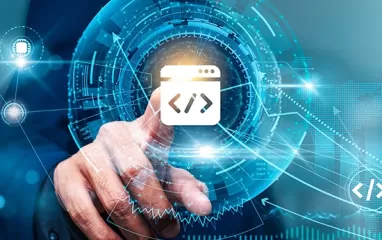Other recent blogs



Let's talk
Reach out, we'd love to hear from you!
There was once a time when large corporations invested in building applications using C/C++. However, as the technology evolved, so did the usage of new general-purpose languages that are easy to understand and fun to use. Python is one of the easy to learn, robust, extendable, high-level programming language compatible with all major platforms. It is useful across a range of programming tasks from shell automation to web applications. Python is deployable in a wide-range of domains and technical fields including data analytics, finance, scientific, and mathematical algorithms.
Why Do We Need Python?
When thinking about Backend Web Development, data analysis, artificial intelligence, and scientific computing, think about Python. This is the minimum expectation when you want to build productivity tools, games, and desktop apps.
In the past few years, things have changed. Easy to understand and fun to use applications is not the only reason for using Python now. There are a number of reasons. Some of them are:
Data Science and Analytics
Python is a popular language with a number of modules written in C/C++. It is used in developing data science applications because of its speed and ability to multi-process for parallel computing. The language has the distinct advantage of delivering performance in large-scale data science and machine learning projects. For example, tech giant Google has created a deep learning framework called TensorFlow written primarily in Python. Facebook also uses Python packages for specific Data Science jobs. Packages like NumPy, SciPy, and Pandas produce excellent results for data analysis jobs. Python has a variety of data science/data analytics libraries that has helped the language gain popularity and become a beginner-friendly language.
Areas of Usage
Internet Search, Digital Advertisements (Targeted Advertising and Re-targeting), Image Recognition, Speech Recognition, Gaming, Price Comparison Websites etc.
Machine Learning
Python uses NumPy for numerical linear algebra, CVXOPT for convex optimization, and SciPy for general scientific computing, SymPy for symbolic algebra, and PYMC3 and Statsmodel for statistical modeling. It uses the basics of machine learning algorithm including logistic regression and linear regression to develop machine learning systems for predictions by way of its scikit-learn library.
It is easy to customize neural networks and deep learning models with the help of Keras, Theano, and TensorFlow libraries of Python. Libraries that can be used for machine learning projects are:
- PyBrain: It has a flexible, simple, and effective algorithm for machine learning tasks. PyBrain is a modular Machine Learning Library for Python with predefined environments to test and compare your algorithms.
- PyML – A bilateral framework written in Python, PyML focuses on Support Vector Machines (SVMs) and other kernel methods. The library can only work on Linux and Mac OS X.
- scikit-learn – The library provides easy and powerful solutions that are reusable in various contexts. It integrates the classic machine learning algorithms in the tightly-knit world of scientific Python packages (NumPy, SciPy, Matplotlib).
- MDP-Toolkit: It is a Python data processing framework that can be easily expanded. MDP-Toolkit has a collection of supervised and unsupervised learning algorithms and other data processing units that can be combined into data processing sequences and more complex feed-forward network architectures. The implementation of the new algorithms of the framework is easy and intuitive. The framework uses signal processing methods (Principal Component Analysis, Independent Component Analysis, Slow Feature Analysis), manifold learning methods ([Hessian] Locally Linear Embedding), classifiers, probabilistic methods (Factor Analysis, RBM), data pre-processing methods, and many others.
Areas of Usage
Financial Services (Banks and other businesses), Healthcare(Patient's health and improved diagnoses and treatment), Government(Fraud detection and minimize identity theft, increase efficiency, and reduce cost), Marketing and sales(personalize a shopping experience, marketing campaign) etc.
AI (Artificial Intelligence)
Python is a language with the best compilation of Lisp and Java. There are a number of benefits of using Python over other programming languages for AI:
Python Development Services is a language with the best compilation of Lisp and Java. There are a number of benefits of using Python over other programming languages for AI:
- High-quality documentation
- Platform agnostic and present in virtually every *nix distribution
- Easy and fast to learn in comparison to any other object-oriented language
Python has many image intensive libraries like Python Imaging Library, VTK and Maya 3D Visualization Toolkits, Numeric Python, Scientific Python, and many other tools available for numeric and scientific applications developed for machine learning. Some more libraries that Python can use for creating AI projects are:
- AIMA: Python implementation of algorithms from Russell and Norvig’s ‘Artificial Intelligence: A Modern Approach’
- pyDatalog: Logical programming engine in Python
- SimpleAI: Python implementation of many of the artificial intelligence algorithms described in the book “Artificial Intelligence, a Modern Approach.” It focuses on providing easy-to-use, well-documented, and tested library
- EasyAI: Simple Python engine for two-player games with AI (Negamax, Transposition tables, Game solving)
Areas of Usage
Virtual Personal Assistants, Video Games, Smart Cars, Fraud Detection, Online Customer Support, Security Surveillance etc.
Automation
Using Python, you can write a script that perform operations automatically from downloading reports in CSV/Excel format from different sources to creating a consolidated Excel report in the specified format. For example, search text in a file or across multiple files, create, update, move, and rename files and folders, search the Web and download online content, update and format data in Excel spreadsheets of any size, split, merge, watermark, and encrypt PDFs, send reminder emails and text notifications, and fill online forms.
Python shrinks the gap between capturing valid requirements, writing code, and designing automated tests. Rooted in strong daily cross-functional collaboration, Python ensures speedy, qualitative, and high-value applications for customers.



